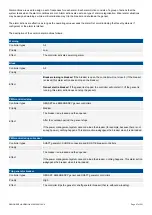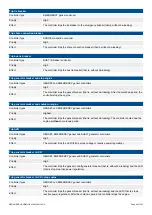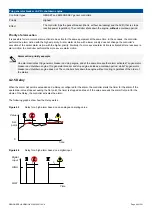
Alarm process
Normal
No
Yes
Alarm
condition
still?
Yes
No
Alarm
condition
Inhibit?
Yes
No
Delay timer
expired?
No
Yes
Disabled
alarm?
Alarm
handling
The controller detects an
Alarm condition
.
Check whether the alarm is disabled.
Check whether the alarm has an active inhibit.
Check whether the
Alarm condition
is still present.
The alarm is not activated until the delay timer has
expired.
Check whether the
Alarm condition
is still present.
The alarm is activated and included in the alarm list.
When an alarm condition is met (typically, the operating value reaches the
Set point
), then the controller starts the
Time delay
.
During this period the controller checks whether the
Alarm condition
is still present. If not, the alarm returns to normal.
•
If the
Alarm condition
continues after the
Time delay
has expired:
◦
The alarm becomes active in the system.
◦
The alarm requires action and acknowledgement.
•
If the
Alarm condition
clears after the
Time delay
has expired:
◦
The associated alarm does not become active, unless a
Latch
is present on the alarm.
◦
The alarm requires acknowledgement.
The alarm results in both a visual and audible (if a horn is correctly installed) indication (subject to design of the system) for the
operator. The system controls the alarm states as necessary based upon the operational conditions. Some alarms can be
configured to be automatically acknowledged.
INFO
Auto acknowledge
can be useful during commissioning and troubleshooting. However, DEIF does not recommend
Auto
acknowledge
during normal operation.
During operation the system continues to monitor the
Alarm condition(s)
and moves alarms between different states as necessary.
Operator action can also move the alarm(s) to other states.
DESIGNER'S HANDBOOK 4189340911K UK
Page 91 of 521
















































